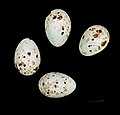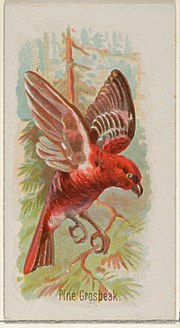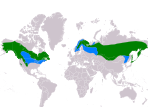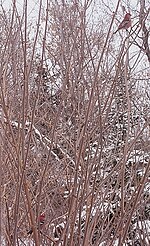The pine grosbeak (Pinicola enucleator) is a large member of the true finch family, Fringillidae. It is the only species in the genus Pinicola. It is found in coniferous woods across Alaska, the western mountains of the United States, Canada, and in subarctic Fennoscandia and across the Palearctic to Siberia. The species is a frugivore, especially in winter, favoring small fruits, such as rowans (mountain-ashes in the New World). With fruit-crop abundance varying from year to year, pine grosbeak is one of many subarctic-resident bird species that exhibit irruptive behavior. In irruption years, individuals can move long distances in search of suitable food supplies, bringing them farther south and/or downslope than is typical of years with large fruit crops.
Taxonomy
The pine grosbeak was formally described in 1758 by the Swedish naturalist Carl Linnaeus in the tenth edition of his Systema Naturae under the binomial name Loxia enucleator.[2] The type locality is Sweden.[3] It is now the only species placed in the genus Pinicola that was erected in 1808 by the French ornithologist Louis Pierre Vieillot.[4][5] The generic name Pinicola combines the Latin pinus meaning "pine tree" and colere meaning "to dwell"; the specific enucleator is from the Latin enucleare meaning "to remove the kernel".[6]
The pine grosbeak is a sister taxon to the bullfinches of the genus Pyrrhula.[7] The crimson-browed finch (Carpodacus subhimachalus) was previously placed in the genus Pinicola. It was moved to the rosefinch genus Carpodacus based on results from phylogenetic studies of mitochondrial and nuclear DNA sequences that were published in 2012 and 2013.[5][7][8]
Eight subspecies are recognised:[5]
- P. e. enucleator (Linnaeus, 1758) – Scandinavia to central Siberia
- P. e. kamtschatkensis (Dybowski, 1883) – northeastern Siberia
- P. e. sakhalinensis Buturlin, 1915 – Sakhalin and the Kuril Islands, northern Japan
- P. e. flammula Homeyer, 1880 – coastal southern Alaska and western Canada
- P. e. carlottae Brooks, AC, 1922 – the Queen Charlotte Islands (off western Canada)
- P. e. montana Ridgway, 1898 – inland southwestern Canada to west-central U.S.
- P. e. californica Price, 1897 – eastern California
- P. e. leucura (Müller, PLS, 1776) – inland west, central Alaska to eastern Canada and northern New England (U.S.)
Description
This species is one of the largest species in the true finch family. It measures from 20 to 25.5 cm (7.9 to 10.0 in) in length and weighs from 52 to 78 g (1.8 to 2.8 oz), with an average mass of 56.4 g (1.99 oz). The pine grosbeak's wingspan is 13.0 in (33 cm).[9] Among standard measurements, the wing chord is 10.2 to 11.6 cm (4.0 to 4.6 in), the tail is 7.8 to 9.5 cm (3.1 to 3.7 in), the bill is 1.4 to 1.65 cm (0.55 to 0.65 in) and the tarsus is 1.9 to 2.3 cm (0.75 to 0.91 in).[10][11][12] Adults have a long forked black tail, black wings with white wing bars and a large bill. Adult males have a rose-red head, back and rump, They also possess black wings and tail, with a conical beak. Adult females are olive-yellow on the head and rump and grey on the back and underparts. Young birds have a less contrasting plumage overall, appearing shaggy when they moult their colored head plumage.
Its voice is geographically variable, and includes a whistled pui pui pui or chii-vli. The song is a short musical warble.
Distribution and habitat

Pine grosbeaks breed in the boreal forests of northern Eurasia and North America, and typically either remain resident near their breeding grounds or migrate relatively short distances to the southern extent of boreal forests. During irruptive years, more travel to southern boreal forests and some move further south. In such years in the New World, they can occur well south of their typical winter distribution, which is the northern Great Lakes region and northern New England in the United States. This species is a very rare vagrant to temperate parts of Europe; in all of Germany, for example, not more than 4 individuals per year and often none at all have been recorded since 1980.[13] The birds have also been known to live in coniferous forests, and other woodlands of the sort.
Behaviour and ecology
The breeding habitat of the pine grosbeak is coniferous forests. They nest on a horizontal branch or in a fork of a conifer. This bird is a permanent resident through most of its range; in the extreme north or when food sources are scarce, they may migrate farther south. When breeding both sexes develop gular pouches which they use to store seeds before feeding them to the young.[14]
Pine grosbeaks forage in trees and bushes. They mainly eat seeds, buds, berries, and insects. Outside of the nesting season, they often feed in flocks.
-
Immature male
-
Front view of female, notice forked tail, Gatineau Park, Quebec
-
Eggs of Pinicola enucleator MHNT
References
- ^ BirdLife International (2018). "Pinicola enucleator". IUCN Red List of Threatened Species. 2018: e.T22720625A132141177. doi:10.2305/IUCN.UK.2018-2.RLTS.T22720625A132141177.en. Retrieved 11 November 2021.
- ^ Linnaeus, Carl (1758). Systema Naturae per regna tria naturae, secundum classes, ordines, genera, species, cum characteribus, differentiis, synonymis, locis (in Latin). Vol. 1 (10th ed.). Holmiae (Stockholm): Laurentii Salvii. p. 171.
- ^ Paynter, Raymond A. Jr, ed. (1968). Check-List of Birds of the World. Vol. 14. Cambridge, Massachusetts: Museum of Comparative Zoology. p. 284.
- ^ Vieillot, Louis Pierre (1807). Histoire naturelle des oiseaux de l'Amérique Septentrionale : contenant un grand nombre d'espèces décrites ou figurées pour la première fois (in French). Vol. 1. Paris: Chez Desray. p. iv. The volume is dated 1807 on the title page but was not published until the following year.
- ^ a b c Gill, Frank; Donsker, David; Rasmussen, Pamela, eds. (2020). "Finches, euphonias". IOC World Bird List Version 10.1. International Ornithologists' Union. Retrieved 21 April 2020.
- ^ Jobling, James A. (2010). The Helm Dictionary of Scientific Bird Names. London, United Kingdom: Christopher Helm. pp. 147, 307. ISBN 978-1-4081-2501-4.
- ^ a b Zuccon, Dario; Prŷs-Jones, Robert; Rasmussen, Pamela C.; Ericson, Per G.P. (2012). "The phylogenetic relationships and generic limits of finches (Fringillidae)" (PDF). Molecular Phylogenetics and Evolution. 62 (2): 581–596. doi:10.1016/j.ympev.2011.10.002. PMID 22023825.
- ^ Tietze, D.T.; Päckert, M.; Martens, J.; Lehmann, H.; Sun, Y.-H. (2013). "Complete phylogeny and historical biogeography of true rosefinches (Aves: Carpodacus)". Zoological Journal of the Linnean Society. 169: 215–234. doi:10.1111/zoj.12057.
- ^ "Pine Grosbeak Identification, All About Birds, Cornell Lab of Ornithology". www.allaboutbirds.org. Retrieved 2020-09-29.
- ^ CRC Handbook of Avian Body Masses by John B. Dunning Jr. (Editor). CRC Press (1992), ISBN 978-0-8493-4258-5.
- ^ Clement, Peter; Harris, Alan; Davis, John (1993). Finches and Sparrows: an Identification Guide. Princeton, New Jersey: Princeton University Press. ISBN 0-691-03424-9.
- ^ Adkisson, C. S. (1999). "Pine grosbeak (Pinicola enucleator)". In Poole, A. (ed.). The Birds of North America Online. Ithaca: Cornell Lab of Ornithology.
- ^ Töpfer, Till (2007). "Nachweise seltener Vogeltaxa (Aves) in Sachsen aus der ornithologischen Sammlung des Museums für Tierkunde Dresden" [Records of rare bird taxa (Aves) in Saxony from the ornithological collection of the Zoological Museum Dresden] (PDF). Faunistische Abhandlungen (in German). 26 (3): 63–101.[permanent dead link]
- ^ French, Norman R. (1954). "Notes on breeding activities and on gular sacs in the Pine Grosbeak" (PDF). The Condor. 56 (2): 83–85. doi:10.2307/1364663. JSTOR 1364663.
External links
- "Pine grosbeak media". Internet Bird Collection.
- Pine Grosbeak – Pinicola enucleator – USGS Patuxent Bird Identification InfoCenter
- Xeno-canto: audio recordings of the pine grosbeak
- Pine grosbeak photo gallery at VIREO (Drexel University)
|
Help
|
|
Browse
|
Search
|
Create the page "Pine Grosbeak" on this wiki!
- English Pine grosbeak, Kenai National Wildlife Refuge, Alaska...(752 × 611 (1.06 MB)) - 19:55, 25 October 2023
- From the Great Lakes Image Collection Pine grosbeak - (Pinicola enucleator) English...(2,767 × 1,908 (2.99 MB)) - 17:01, 14 December 2022
- English Pine Grosbeak, from the Song Birds of the World series (N42) for Allen & Ginter Cigarettes, print, George S. Harris & Sons (MET, 63.350.202.42...(3,105 × 2,819 (1.88 MB)) - 12:14, 27 May 2024
- English Pine Grosbeak, from the Song Birds of the World series (N23) for Allen & Ginter Cigarettes, print, George S. Harris & Sons (MET, 63.350.201.23...(1,559 × 2,840 (1.17 MB)) - 12:14, 27 May 2024
- BY-SA 4.0 Creative Commons Attribution-Share Alike 4.0 truetrue English Pine grosbeak (Pinicola enucleator) male and female in Algonquin Park author name...(3,052 × 1,578 (576 KB)) - 07:42, 3 July 2024
- BY-SA 4.0 Creative Commons Attribution-Share Alike 4.0 truetrue English Pine grosbeak (Pinicola enucleator) male in Algonquin Park author name string: Mykola...(2,181 × 1,683 (1.66 MB)) - 03:56, 3 July 2024
- (Linnaeus, 1758) Vernacular names [edit specified wikidata 'Pine Grosbeak'] English: Pine Grosbeak العربية: خداش مبذول مصرى: خداش مبذول Atikamekw: Kwakeatcipicic...4 KB (400 words) - 20:59, 12 May 2018
- Creative Commons Attribution-Share Alike 3.0 truetrue English Map of Pine Grosbeak ''Pinicola enucleator'' Slovak Mapa druhu smrečiar krivonosí ''Pinicola...(1,052 × 744 (19.64 MB)) - 19:04, 2 April 2024
- DescriptionPine Grosbeak (5927976079).jpg Pine Grosbeak Date 30 December 2007, 22:14 Source Pine Grosbeak Author dfaulder...(3,072 × 2,040 (1.04 MB)) - 11:15, 21 June 2024
- DescriptionPine Grosbeak II.jpg English: Pine Grosbeak in northern Saskatchewan Unknown hakengimpel in nordsaskatchewanUnknown hakengimpel in nordsaskatchewan...(834 × 719 (240 KB)) - 17:03, 14 December 2022
- DescriptionPine Grosbeak (15413664323).jpg A female or juvenile pine grosbeak. Date 13 February 2014, 11:31 Source Pine Grosbeak Author Susan Drury from...(1,000 × 664 (327 KB)) - 11:53, 25 June 2024
- DescriptionPine Grosbeak (15980707666).jpg male on Siberian Elm Date 9 December 2014, 11:50 Source Pine Grosbeak Author Per from Kaministiquia, Canada...(2,047 × 1,360 (362 KB)) - 16:59, 26 June 2024
- DescriptionPine Grosbeak, female.jpg English: Pine Grosbeak (Pinicola enucleator), female, Gatineau Park, Quebec Date 30 March 2008 Source Own work Author...(800 × 1,000 (196 KB)) - 17:01, 14 December 2022
- DescriptionPine Grosbeak (Columbia).jpg English: Pine Grosbeak, Logan Lake, British Columbia Date 23 December 2015, 12:36:17 Source naturespicsonline...(1,100 × 733 (745 KB)) - 22:45, 28 May 2022
- DescriptionPine Grosbeak 357471739.jpg English: Photo of Pine Grosbeak uploaded from iNaturalist. Date 14 February 2024 Source https://www.inaturalist...(1,536 × 2,048 (1.35 MB)) - 12:30, 16 May 2024
- DescriptionPine Grosbeak.jpg English: Pine Grosbeak in northern Saskatchewan Deutsch: Hakengimpel in NordSaskatchewan Date 22 July 2012 Source Own work...(501 × 822 (164 KB)) - 17:01, 14 December 2022
- DescriptionPine Grosbeak - 39748993011.jpg English: Andy's first day at Sax Zim Bog in Forbes, Minnesota - with Miguel Acosta and Frank Nicoletti. Date...(2,804 × 2,110 (1.75 MB)) - 22:52, 24 October 2023
- DescriptionPine Grosbeak - 51844230805.jpg English: Hawrelak Park, Edmonton, Alberta Date 25 January 2022, 09:54:30 Source https://www.flickr...(2,826 × 2,826 (4.45 MB)) - 11:38, 1 July 2024
- DescriptionMale pine grosbeak (6753211053).jpg Male Pine Grosbeak - one of my favorite birds Date 17 March 2011, 13:29 Source male pine grosbeak Author Susan...(800 × 715 (75 KB)) - 08:35, 21 May 2024
- DescriptionPine Grosbeak - 39717078072.jpg English: Andy's first day at Sax Zim Bog in Forbes, Minnesota - with Miguel Acosta and Frank Nicoletti. Date...(2,856 × 1,971 (1.26 MB)) - 22:25, 13 July 2024























Recent Comments